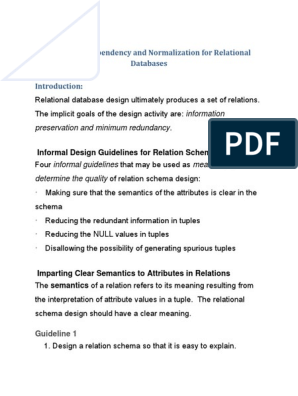0% found this document useful (0 votes)
24 views37 pages05 - Relational Database Design - Week 05
The document outlines guidelines for designing relational database management systems (RDBMS), emphasizing the importance of avoiding anomalies such as insertion, deletion, and update anomalies to maintain data integrity. It discusses functional dependencies and normalization, detailing the various normal forms (1NF, 2NF, 3NF, BCNF, 4NF, 5NF) that help structure databases efficiently. Additionally, it defines keys, superkeys, and candidate keys, which are essential for uniquely identifying rows in tables.
Uploaded by
vamikabhardwaj9Copyright
© © All Rights Reserved
We take content rights seriously. If you suspect this is your content, claim it here.
Available Formats
Download as KEY, PDF, TXT or read online on Scribd
0% found this document useful (0 votes)
24 views37 pages05 - Relational Database Design - Week 05
The document outlines guidelines for designing relational database management systems (RDBMS), emphasizing the importance of avoiding anomalies such as insertion, deletion, and update anomalies to maintain data integrity. It discusses functional dependencies and normalization, detailing the various normal forms (1NF, 2NF, 3NF, BCNF, 4NF, 5NF) that help structure databases efficiently. Additionally, it defines keys, superkeys, and candidate keys, which are essential for uniquely identifying rows in tables.
Uploaded by
vamikabhardwaj9Copyright
© © All Rights Reserved
We take content rights seriously. If you suspect this is your content, claim it here.
Available Formats
Download as KEY, PDF, TXT or read online on Scribd
/ 37




















































































